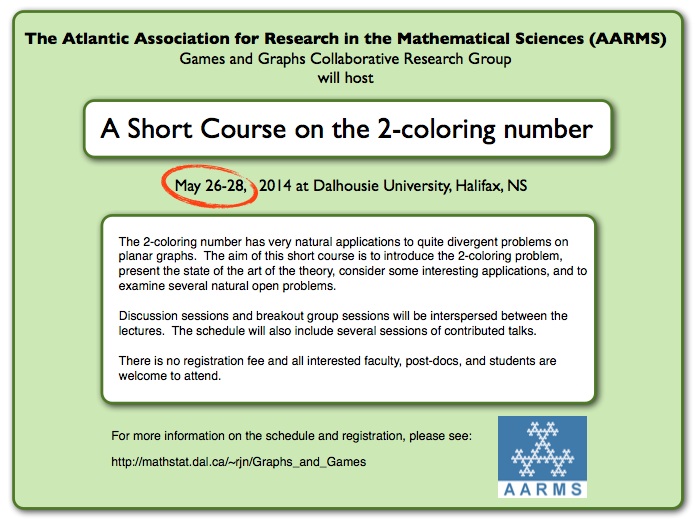Workshop by
Dr Hal Kierstead

Workshop by
Dr Hal Kierstead





This is the SECOND announcement of the Short Course offered by the Graphs-and-Games group.
Time: May 26-28, 2014 (see below for schedule of events)
Place: Colloquium Room, Dept of Math. and Stats., Dalhousie University
Speaker: Dr Hal Kierstead.
There are time slots for contributed talks (15 mins + 5 mins for questions).
Please send a Title and Abstract to Richard Nowakowski or M.E. Messinger.
A brief overview of the short course.
Speaker: Dr H. Kierstead.
Title: the 2-coloring number
1. 2-coloring number seems like a simple minded idea, but it has had very natural applications to quite divergent problems on planar graphs, and the concept is not well known.
2. One of these applications is to the game chromatic number and its cousin game coloring number.
3. The game coloring number has at least one application to a nongame problem. I would like to find more.
4. There are two natural open questions—Is it polynomial to compute the 2-coloring number? What is the maximum 2-coloring number of planar graphs. It is either 8 or 9. It is easy (with an idea) to show 12, 10 is not much harder, and it would be feasible to do 9. The lower bound is an easy example.
5. There is a hierarchy of coloring numbers and game coloring numbers that arises from applications, and it is closely tied to Nesitril’s work on bounded expansion.
—————————
Tentative Schedule:
Monday May 26
9:00-9:10am Mingle
9:10-10:30: Contributed Talks:
9:10-10:05: Ursel Erey (Dal), “$\sigma$-Polynomials”
10:05-10:30 David Pike (Mem), “Triple Systems, Gray Codes and Snarks”
10:30-11:00 Break
11:00-12:00 Short Course Lecture 1
12:00-2:00 Lunch
2:00-3:00 Short Course Lecture 2
3:00-3:30 Break
3:30-4:30 Math Dept. Colloquium Larry Ericksen: "Patterns in Art: How mathematics has informed the history of art"
Tuesday May 27
9:00-9:10am Mingle
9:10-10:30 Short Contributed Talks
10:30-11:00 Break
11:00-12:00 Short Course Lecture 3
12:00-2:00 Lunch
2:00-3:00 Short Course Lecture 4
3:00-3:30 Break
3:30-5:00 Discussions and Breakout Groups.
Wednesday May 28
9:00-9:10am Mingle
9:10-10:10 Short Course Lecture 5
11:00-12:00 Break, Discussions and Breakout Groups.
12:00-2:00 Lunch
2:00-3:00 Short Course Lecture 6
3:00-3:30 Break
3:30-5:00 Wrap up.
————————————————
Abstracts:
Contributed Talks:
U. Erey (Dal), “ $\sigma$-Polynomials”
Given a graph $G$ of order $n$, the $\sigma -polynomial$ of $G$ is the generating function $\sigma(G,x)=\sum a_i x^i$ where $a_i$ is the number of partitions of the vertex set of $G$ into $i$ nonempty independent sets. Such polynomials arise in a natural way from chromatic polynomials, and have strong connections to several other well known polynomials in combinatorics. Brenti proved that $\sigma$-polynomials of graphs with chromatic number at least $n-2$ had all real roots, and conjectured the same held for chromatic number $n-3$. We affirm this conjecture.
David Pike (Mem) “Triple Systems, Gray Codes and Snarks”
The 2-block-intersection graph of any simple twofold triple system is
necessarily a cubic graph. If it is Hamiltonian then a 2-intersecting
cyclic Gray code for the design can be found. If it is not Hamiltonian
then the graph has the potential to be a somewhat rare type of graph known
as a snark.
——
Colloquium:
Larry Ericksen: is an artist and mathematician living in New Jersey. He is currently visiting Dalhousie for a mathematical research collaboration.
"Patterns in Art: How mathematics has informed the history of art"
This talk will be concerned with the application of certain mathematical patterns to artwork, past and present. Special mathematical topics will be highlighted in works of art, from the Parthenon to patchwork quilts. The golden ratio, which appears in art and nature, has been used in art from classical times. The Fibonacci sequence, first described in the twelfth century, provides a compositional tool used in the golden rectangle and the Fibonacci spiral. Artists from Da Vinci to Dali have employed these mathematical structures.
Several art movements based on mathematical objects have developed in Europe and North America, and special attention will be given to relevant paintings by Canadian artists. In the two dimensional arts and crafts, such as paintings and quilts, coloured block patterns are arranged to evoke visual responses, emotional or intellectual. Coloured squares on a grid can be placed randomly or distributed according to mathematical rules by congruences and periodicities over a number array lattice.
This talk will also cover the geometric constructs of polygon tessellations, Escher designs, and Penrose tilings.